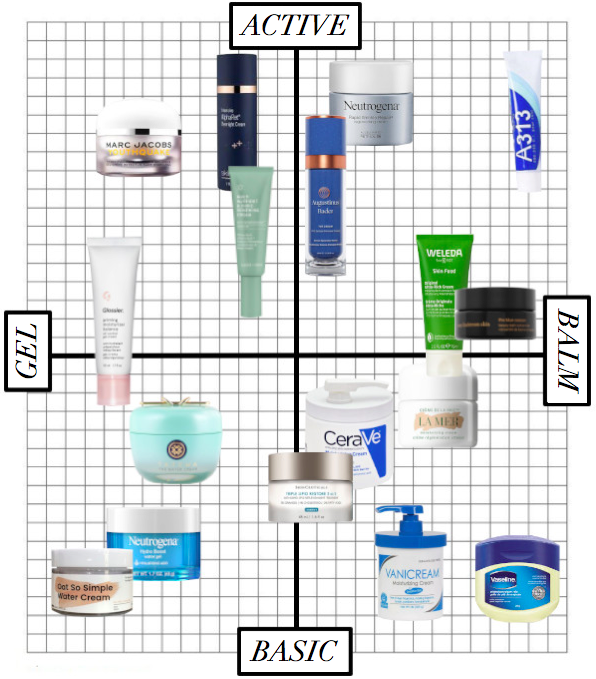Ah, the “humble” moisturizer. If it’s really as humble as it claims, riddle me this: shouldn’t choosing the right one be as easy as walking to your local beauty store, closing your eyes, doing a little spinny-spin in the moisturizer aisle and taking home whatever your finger lands on first?
Of course, it is not. Folks with dry skin want something that’ll keep potential flakes buckled down and inside the vehicle at all times. Got oily skin? You probably waffle between knowing you need to moisturize, and not wanting to because it just makes you greasier. Those who tend towards sensitivity might look for something super simple, but if they do want to venture into actives, a moisturizer-bound version will help minimize irritation. Lazies want to streamline, fanatics want to do the most, and organic shoppers want to storm the Capitol slather themselves in botanical whips. Brands want to serve them all!
At its most simplified, any moisturizer has to fall somewhere between two axes. First, you’ve got to decide whether it’s more like a gel or a balm. Gels are lightweight, water-based, and best for those with oily skin, while balms are thick, oily, and preferable when your skin needs more protection from the elements. Then you’ve got to address the claims. The most basic moisturizers will leave your skin more moisturized—duh. But active moisturizers multitask by taking on resurfacing, brightening, or collagen-boosting at the same time.
There are far too many moisturizers on the market to fit into one small graph, but I picked some examples to give you the gist.

If we start off in quadrant one, you might feel a little disoriented—the lights are dimmed low, fragrance perfumes the air, and a cup of tea steams beside you. You’ve entered the sleepytime quadrant, titled as such because heavy, active moisturizers are usually reserved for night. Buffer active ingredients with a soothing, buttery base and even those with more sensitive skin types can suddenly tolerate things like retinoids with minimal irritation. Neutrogena’s Rapid Wrinkle Repair is a classic retinol cream, but if you want something heavier go for A313 Pommade’s waxy consistency. It’s one of the few truly active balms out there. Botanical balms like Weleda Skin Food and May Lindstrom’s Blue Cocoon still sit above the east-west axis because essential oils can treat some and inflame others. And Augustinus Bader’s The Rich Cream occupies a unique position because, although the brand insists you can replace your retinoids with its stem cell tech, the active ingredients don’t come with the same potential for irritation. (Read: less cushion necessary.)
The right hand side of quadrant two is where you’ll find your lotion textures. Instead of heavy butters and oils, a lotion usually relies on lightweight moisturizers like ceramides to lock in hydration without adding shine. Skinbetter’s Alpharet is the most active of the bunch. (When I use it on my dry skin, I actually sandwich it with another moisturizer.) Super active moisturizers are rarely pure gels, but Marc Jacobs’ Youthquake is a good example of one—it combines resurfacing AHAs with a watery base. It’s best left to the truly oily. Moving lower on our vertical axis, you’ll find Top 25 winning Multi Nutrient & Dioic Cream from Allies of Skin. This light lotion has a lot going on, but most of its active ingredients are there to soothe breakouts into submission, not pummel them. Straddling the axes is Priming Moisturizer Balance, but niacinamide and willow bark, a natural source of salicylic acid, push it up into active territory.
Step into quadrant three and everything starts to feel a little… hotter. That’s because these watery gels feel best in summertime, when you don’t need the extra protection a cream or balm provides. A gel texture is also ideal for those with oily skin reluctant to moisturize. All you really need is a burst of hydration! ITG’s resident oily skin expert and Senior Editor Ashley Weatherford is partial to Tatcha’s oil-free Water Cream, which purports gentle pore-clarifying action via Japanese Leopard Lily. Neutrogena’s Hydro Boost has a similar texture, but doesn’t do anything but hydrate. All the way in the bottom left corner is Krave’s Oat So Simple. Soothing oat, a streamlined ingredient list and no added fragrance makes it good for those with super oily, super sensitive skin—plus, this cooling gel sinks in pretty much immediately.
And finally, quadrant four is home to your platonic ideal of a moisturizer. Thick, white, probably in a tub… that’s the stuff you’ll find in here. I’ve been slathering my face in Skinceuticals’ Triple Lipid Repair as of late, which feels thick but sinks quick and dries deceptively matte. It’s a derm favorite but so is Cerave cream, at a fraction of the price. A big difference is that the latter has a lick of niacinamide. La Mer (the original) has a cold cream-ish consistency. It’s steeped in “miracle broth,” the proprietary blend of ingredients that makes La Mer so good and so pricey—they’d say it makes the difference between a $345 cream and petroleum jelly. Speaking of, Vaseline occupies the bottom right corner of this grid! The one-hit-wonder seals in moisture, and that’s it. If you’re not Charlotte Palermino, Vanicream is a slightly lighter option that’s very plain, and good for those with sensitive skin and eczema.
Where does your favorite moisturizer fall? Let’s fill in the gaps.
—Ali Oshinsky
Photo via ITG





